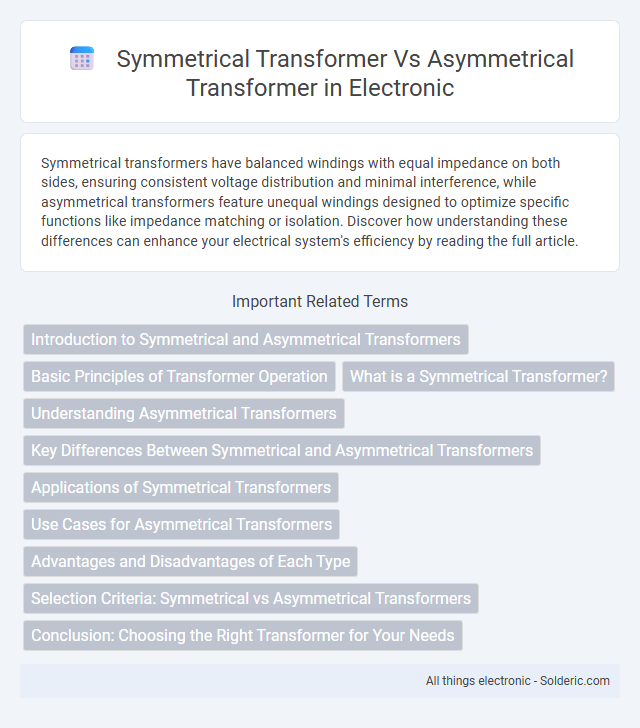Symmetrical transformers have balanced windings with equal impedance on both sides, ensuring consistent voltage distribution and minimal interference, while asymmetrical transformers feature unequal windings designed to optimize specific functions like impedance matching or isolation. Discover how understanding these differences can enhance your electrical system's efficiency by reading the full article.
Comparison Table
| Feature | Symmetrical Transformer | Asymmetrical Transformer |
|---|---|---|
| Winding Ratio | Equal turns on primary and secondary | Unequal turns on primary and secondary |
| Voltage Output | Same as input voltage | Different from input voltage (step-up or step-down) |
| Use Case | Impedance matching and isolation | Voltage transformation (step-up or step-down) |
| Efficiency | High, minimal losses | Generally high, depends on design |
| Design Complexity | Simple winding design | More complex due to different winding turns |
| Typical Applications | Audio circuits, signal isolation | Power distribution, voltage regulation |
Introduction to Symmetrical and Asymmetrical Transformers
Symmetrical transformers feature equal primary and secondary windings that provide balanced voltage and current, making them ideal for applications requiring uniform power distribution. Asymmetrical transformers have unequal winding turns, resulting in different voltage levels between primary and secondary sides, suited for step-up or step-down functions. Understanding these differences helps you select the appropriate transformer based on specific voltage and load requirements.
Basic Principles of Transformer Operation
Symmetrical transformers operate with equal voltage and current ratings on both primary and secondary windings, allowing balanced impedance and power transfer. Asymmetrical transformers feature different ratings on each winding, enabling voltage step-up or step-down functions for diverse applications. The core principle involves electromagnetic induction, where AC voltage in the primary coil generates a magnetic flux in the core, inducing a proportional voltage in the secondary coil based on the turns ratio.
What is a Symmetrical Transformer?
A symmetrical transformer features equal winding turns and impedance on both the primary and secondary sides, enabling balanced voltage and current distribution. This design minimizes distortion and improves efficiency in signal transmission and power conversion applications. Commonly used in audio systems and power distribution, symmetrical transformers enhance performance by maintaining consistent phase relationships.
Understanding Asymmetrical Transformers
Asymmetrical transformers feature windings with different numbers of turns or configurations, resulting in unbalanced voltage or current ratios tailored for specific applications like signal isolation or impedance matching. Unlike symmetrical transformers that provide equal voltage and current distribution, asymmetrical transformers optimize performance where one side requires different electrical characteristics. Understanding asymmetrical transformers helps you design circuits with customized voltage transformation and improved efficiency in specialized electronic systems.
Key Differences Between Symmetrical and Asymmetrical Transformers
Symmetrical transformers have equal turns and impedances on both primary and secondary windings, enabling balanced voltage and current distribution, while asymmetrical transformers feature unequal turns and impedance, resulting in unbalanced output. Symmetrical transformers are commonly used in applications requiring uniform power delivery, such as audio systems and balanced signal transmission. Asymmetrical transformers are preferred in scenarios needing voltage step-up or step-down with different load requirements, including power supplies and impedance matching tasks.
Applications of Symmetrical Transformers
Symmetrical transformers are widely used in applications requiring balanced voltage outputs, such as audio equipment, telecommunications, and precision measurement devices, ensuring minimal distortion and noise. They provide equal impedance and identical voltage levels on both sides of the transformer, which improves signal integrity and reduces electromagnetic interference. Your systems benefit from symmetrical transformers in scenarios demanding high fidelity and balanced load sharing.
Use Cases for Asymmetrical Transformers
Asymmetrical transformers are commonly used in audio equipment to match impedances between devices with different signal levels, such as connecting a microphone to an amplifier input. They are essential in power distribution systems where voltage needs to be stepped up or down unevenly to accommodate different load requirements. These transformers are also utilized in isolation applications to reduce noise and ground loop issues in electronic circuits.
Advantages and Disadvantages of Each Type
Symmetrical transformers provide balanced voltage and current outputs, reducing electromagnetic interference and improving signal integrity, making them ideal for audio and communication systems; however, they tend to be more complex and costly to manufacture. Asymmetrical transformers offer simpler design and lower production costs, often used in power supply applications but can introduce signal distortion and imbalance, affecting performance in sensitive equipment. Selecting between symmetrical and asymmetrical transformers depends on the need for signal fidelity versus cost efficiency and application requirements.
Selection Criteria: Symmetrical vs Asymmetrical Transformers
Selection criteria for symmetrical versus asymmetrical transformers depend on your application's load balance and efficiency needs. Symmetrical transformers are ideal for balanced loads and provide consistent voltage regulation, while asymmetrical transformers are better suited for unbalanced loads, allowing optimized performance and cost efficiency. Evaluating load characteristics, harmonics, and installation environment will guide you in choosing the right transformer type for your electrical system.
Conclusion: Choosing the Right Transformer for Your Needs
Symmetrical transformers provide balanced voltage outputs ideal for high-precision applications requiring minimal noise and interference, while asymmetrical transformers offer unbalanced outputs suitable for simpler, cost-effective designs. Your choice depends on the specific requirements of signal integrity, power handling, and application complexity. Selecting the right transformer ensures optimal performance, efficiency, and reliability tailored to your project's needs.
symmetrical transformer vs asymmetrical transformer Infographic

 solderic.com
solderic.com